Common Snakes of South Carolina: South Carolina is a state that offers coastal plains alongside rivers, plateaus and sea islands along with a subtropical and humid climate, all things the average snake needs to thrive. Bordering Georgia, a state home to many different species of snake, you can imagine that many of them happily cross state borders. Many of the common snakes of South Carolina are the same as those in bordering states. There are 38 species of snake in this state, five of which are are venomous. These are:
- Eastern Diamondback Rattlesnake
- Timber Rattlesnake (Also known as Canebrake Rattlesnake)
- Pygmy Rattlesnake - Dusky & Carolina
- Copperhead
- Cottonmouth
Call the below number for snake removal help in your area:
Charleston: 843-325-2666
Columbia: 803-832-2495
Greenville: 864-642-0295
Myrtle Beach: 843-325-2666
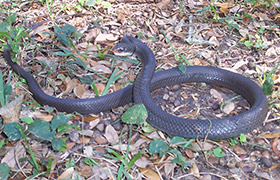
Black Racer: One of the most commonly sighted snakes in South Carolina, the black racer is pretty much as the name suggests - a long, slender and black (or dark colored) snake that grows to about 70 inches. It also goes by a bunch of other names including the black runner, or even the blur runner / racer.
You may find this snake in your back yard looking a little bit like a twig. This is a defense mechanism. It places its body in a ‘kink’ position to look like a twig so predators will just leave it alone.
You may find this snake in your back yard looking a little bit like a twig. This is a defense mechanism. It places its body in a ‘kink’ position to look like a twig so predators will just leave it alone.
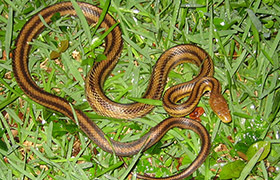
Rat Snakes: You'll find a couple of rat snake species in South Carolina - Black Rat and Yellow Rat (pictured to the left) snakes to be more specific. You’ll also find a cousin of the rat snake - the Corn Snake. The latter is often kept as household pets and are one of the most docile snake breeds you can find.
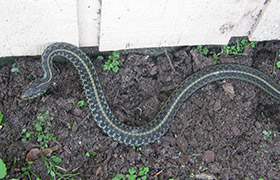
Eastern Garter: The garter snake looks like a garter strap and the eastern garter snake is no exception with solid pale stripes running down a darker brown, grey or olive body. A medium-sized snake that grows to about 25 inches maximum, they’ll eat pretty much anything they can fit in their mouth making them very adaptable. If they had a preference, they’d choose worms, slugs, toads and frogs.
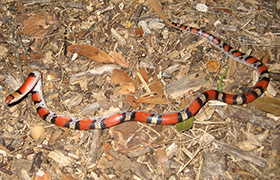
Scarlet Snake: Similar to the scarlet king snake, the scarlet snake has mimicked the red, black and yellow warning markings of the coral snake to help keep safe from predators. Growing to a maximum of about 25 inches, you probably won’t spot a scarlet snake seeing as they’re nocturnal, although if you head to moist woods and forests and look under fallen tree logs or leaf litter, you might just see the bright markings of one.
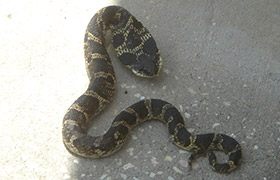
Eastern Hognose Snake: A name earned from the upturned nose to aid with digging around in moist sands and soils for creatures such as frogs and toads, both the eastern and Southern Hognose Snake are common snakes of South Carolina. Only growing to around thirty inches, it might display intimidating behavior when threatened but is actually harmless and contains no venom.
Brown Snake
Next on the list is the humble brown snake, a snake that is very much a dirty or sluggish brown color. The belly is usually a touch lighter - an off-white or cream color, and you may occasionally find patches or diamond-shaped formations running along the length. If you have piles of garbage, litter or garden debris in your back yard, a brown snake might just be hiding beneath it. They love to eat the bugs that thrive in your back yard - snails, slugs and earthworms. Also coming under the same ‘brown snake’ species, you’ll find the Florida Redbelly and Northern Redbelly snakes in South Carolina but less commonly.
Eastern King Snake
The eastern king snake is a relatively popular and common snake among most of the United States but there are two other king snakes you’ll find in South Carolina - Mole King Snake and Scarlet King Snake. With their bright red, yellow, black and white markings, you’d think they were venomous snakes but they're not. They’re just mimicking the coral snake’s markings to ward off predators.
Rough Green Snake
As the name suggests, this snake is a green snake, normally quite bright in color (although shades do vary), well camouflaged for grassy areas which is where you’ll commonly find it. It’s a very thin snake but can grow to be quite long, as much as 45 inches, it’s an insect-eating snake that doesn’t constrict.
Water Snakes
The list of water snakes found in South Carolina include:
- Redbelly Water
- Banded Water
- Florida Green
- Midland Water
- Northern Water
- Brown Water
Eastern Smooth Earth
A snake that seems to be popular in many places across the USA including Ohio and Virginia, the eastern smooth earth snake is a small snake, only about 10-13 inches long, and can often be found in residential back gardens because of their love for earthworms, beetles and other bugs, all of which are easily spotted in the average flower patch.
Although these are the most common snakes of South Carolina, there are many more to add to the list, and the following have all been recorded in the state:
- Northern Ringneck
- Southern Ringneck
- Eastern Worm
- Eastern Mud Snake
- Rainbow Snake
- Eastern Milk
- Eastern Coachwhip
- Pine Snake
- Glossy Crayfish Snake (also Illinois)
- Queen Snake
- Pine Woods Snake
- Carolina Swamp Snake
- Southeastern Crowned
- Peninsula Ribbon
- Eastern Ribbon
- Rough Earth